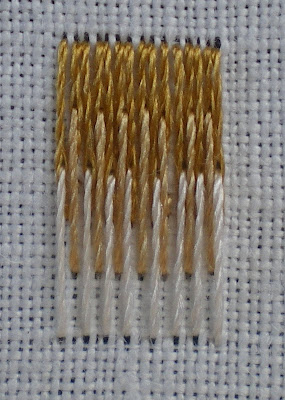The lizardine is left in one piece but stretched a short length at a time to 25-30% longer than its original length. I grasped a 3 cm length firmly between my finger nails and slowly stretched the length of wire until it measured 4 cm, then repeated this with the next 3 cm length, and so on until I had stretched the entire length. The difficult part is making sure that each length is stretched a consistent amount (you can’t unstretch it) and not to damage the part you are grasping with your finger nails. The first little bit of stretch resists you but you must resist the temptation to pull too hard, once the wire begins to give, it stretches much more readily and it would be easy to overdo it. Furthermore, although you can’t unstretch it, there is a certain amount of ‘spring’ so when you release the tension the wire shortens slightly. I’m sure with more experience I would become familiar with all of these factors but on this design there is only a small amount of Lizardine so by the time I was becoming in tune with the wire, I had stretched the entire length!
Next, part of the stretched lizardine is wrapped around 3 strands of Soie de Paris. You don’t cut off a length of lizardine; you wrap the silk into one end of the wire. Again, this is easier said than done. I’m sure there a knack to this but I did not discover it. I tried holding the thread and twisting the wire; I think that this method would have worked well if I had three hands, one to hold the end of the wire and silk, one to hold the silk under tension and one to twist the wire. Mostly I held the end of the wire and silk in one hand and wound the silk into the gaps between the coils of the wire. It worked but it was slow and awkward.
The deepest shade of blue was used for the core on the central roundel and it is couched in place with a single strand of Soie de Paris. The couching stitches should lie over the silk core and allow the gold wire to show. Like the AGT on the Arabesques, I found the wire surprisingly stiff and at first found it difficult to form the oval outline. With a little trial and error, I developed a technique flexing the wire into a nice curve and couching it into place rather than trying to pull the wire into place with the couching stitches. The ends of the lizardine are not sunk but are trimmed so that they meet nicely at the start/finish of the oval. The silk core is sunk and secured on the back of the work.

© Thistle Threads/Carol-Anne Conway
A line of Gilt Pearl Purl Super is stitched inside and outside of the line of lizardine. Pearl Purl is made from a domed wire formed into a tightly wound spring. This gives the wire a beaded appearance similar to a string of tiny gold pearls. Again it can be used as supplied but for this project it is stretched to 25-30% longer than its original length. The technique is exactly the same as for the lizardine. The Gilt Pearl Purl Super is couched with Tire silk which is fine enough to fit between the ‘beads’ and is barely visible. Although the GPPS is still a little stiff, I found it easier to flex this into shape with the lizardine already stitched in place.

© Thistle Threads/Carol-Anne Conway

© Thistle Threads/Carol-Anne Conway

© Thistle Threads/Carol-Anne Conway
The remaining roundels were completed in exactly the same way except that the deepest shade of red was used for the silk core instead of blue.
Happy Stitching



















































